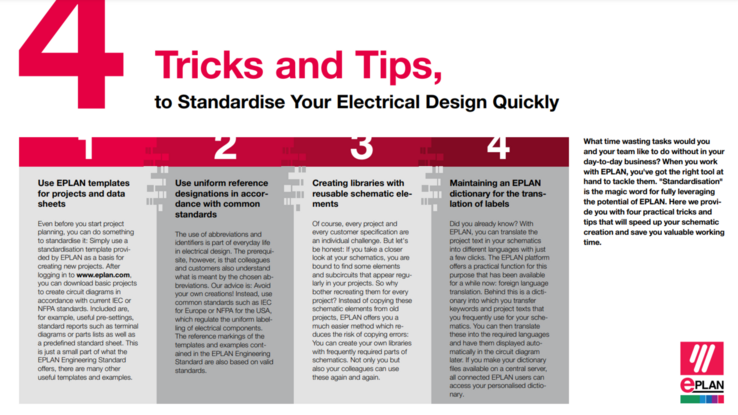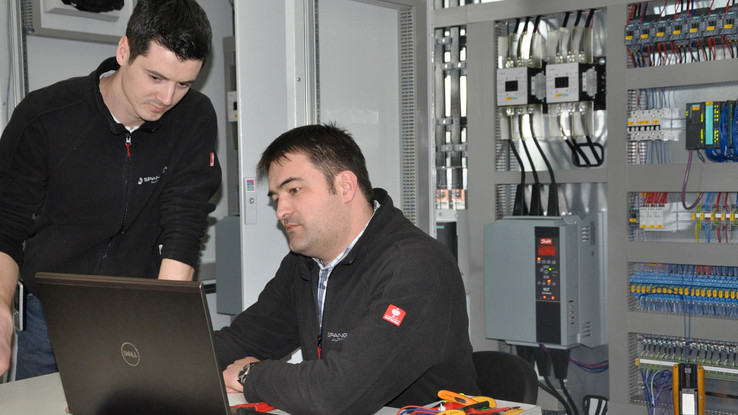Small changes, big impacts:
Standardisation for fast electrical engineering designs
Standardisation in engineering: Perhaps you’re thinking of optimised processes to save time and money? Or maybe about large projects with a lot of changes for which you don’t currently have time due to a shortage of skilled personnel? You needn’t worry: With EPLAN you can use templates, re-use existing data, and harmonise recurring work steps to standardise your electrical designs, saving time and reducing the dependence on the knowledge of individuals. We’re there for you, for each step of the journey.
Is your panel building heading in the right direction?
Let’s take this journey together!
Are you familiar with these everyday hurdles in electrical engineering?
Why change something when it’s been working fine for years? Of course, in well-coordinated teams with experienced electrical engineers, schematic creation runs like clockwork. But let’s be honest, sometimes there are misunderstandings because schematics created by one co-worker sometimes look completely different than those created by another, even when they’re designing the same type of system. Do errors sometimes creep in when elements from other schematics are copied into a different project, whereby the wrong parameters inadvertently get used? Does documentation have to be painstakingly reworked so that it complies with your client’s suppliers’ guidelines during acceptance testing?
Standardise schematic creation, use templates, re-use data: achieve great things in small steps with EPLAN software
What time-wasting tasks would you and your team love to do without in your day-to-day work? If you use the current EPLAN software, you already have the right tool at hand to tackle them. Standardisation is the magic word for exploiting EPLAN’s full potential.
Practical tips:
Small standardisation projects for your electrical engineering design
- Use EPLAN templates for projects and data sheets
- Use uniform reference designations, e.g. according to IEC or NFPA standards
- Set up libraries with re-usable schematic elements
- Maintain an EPLAN library for label creation
Benefits
⇒ Standardise and accelerate schematic creation
⇒ Save time through better collaboration
Further worthwhile steps:
Standardise once, save time on an ongoing basis
- Increase data depth: enrich schematics with additional project information
- Use current standards as the foundation for project planning
- Systematically create libraries with schematics templates and use them across teams
- Derive complete documentation according to client guidelines
Benefits
⇒ Automatically generate bills of materials, terminal diagrams, terminal-connection diagrams, cabling diagrams, etc.
⇒ Re-use partial circuits
⇒ Trouble-free acceptance testing and customer agreements

Seeking to eliminate electrical mistakes and harness technological excellence? "How to Avoid Electrical Mistakes Getting Through to Production: An Electrical Design GUIDE" is your essential resource for mastering electrical design. This downloadable free guide is packed with invaluable insights on reducing errors, minimising costs, and improving productivity and transparency in your electrical design projects.

What time-wasting tasks would you and your team like to do without in your day-to-day business? Standardisation is the magic word for fully leveraging the potential of EPLAN. Here are our 4 tips for simple standardisation projects that will quickly and positively affect your electrical engineering designs. Download it now for free!
How EPLAN supports your standardised engineering while complying with IEC standards
EPLAN's software and services are designed to enable you to create meaningful standards for your electrical engineering designs, by providing you with templates that are already standardised according to applicable industry standards, including IEC, NFPA and more. Likewise, EPLAN develops quality standards for you that facilitate using the applicable standards in everyday work.
Standardise schematics with templates
The EPLAN Engineering Standard supports you from the very start when creating your first projects. Use the free project templates and circuit examples directly directly from EPLAN Cloud as a basis for your projects.
High-quality device data: EPLAN Data Portal
The EPLAN Data Portal provides device data from hundreds of manufacturers which can be directly dragged into your schematic. It contains millions of data sets that meet the EPLAN Data Standard quality criteria and are being updated and expanded on an ongoing basis.
Complementary solutions for current data and easy coordination
Additional software solutions make the current state of your project centrally available for all participants and stakeholders. Work templates, re-usable sub-projects and finished projects can thereby easily be shared, simplifying collaboration coordination and approvals.
EPLAN Software supports standards such as IEC and NFPA
The EPLAN Software supports you in creating schematics, documentation and symbols according to globally valid standards. More local standards such as IEC for Europe, NFPA for the US, and GB for China are also included.



